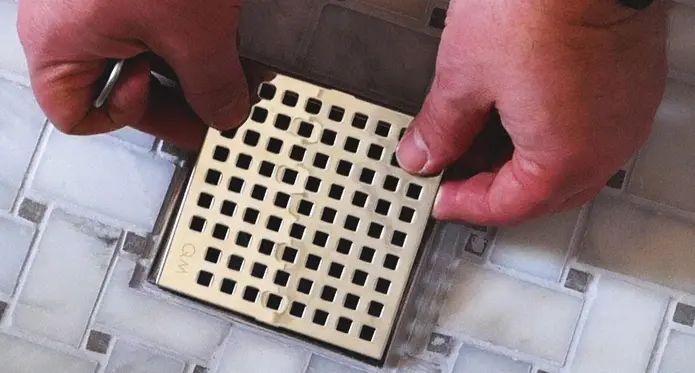Last Updated on October 16, 2023
Nothing ruins a shower drain like the development of black sludge. It’s not only smelly and gross but can end up causing unexpected damage to your shower plumbing system through clogged pipes. So, don’t let an unsuspecting combination of organic materials cause a nasty surprise in your shower drain.
You can’t always remove stubborn black sludge from your shower pipes. But how to clean black sludge from shower drain pipes in your home? There’s a simple and effective way to get rid of it: Boiling water. Pour some boiling water down the drain, and watch as all that nasty stuff melts away like magic.
Maintaining a healthy draining system in your shower with simple methods is absolutely doable. Uncover the mystery behind the dreaded black sludge in your shower’s plumbing system and learn how to proactively avoid it from forming again.
How to Clean Black Sludge from Shower Drain Pipes at Your Home?
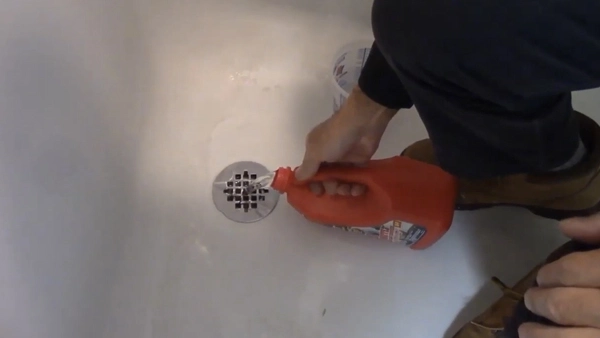
Black sludge buildup in shower drains can be a complex problem to deal with, but fortunately, there are several methods you can use to remove the black sludge from your shower drain and keep it free of blockages, such as:
Cleaning Black Sludge with Boiling Water
Boiling water is one of the simplest ways to break down and remove black sludge from your shower drain. To start, boil enough water to fill an entire pot or bucket. Once the water has come to a full boil, slowly pour it into the affected area of your shower drain.
You must pour the boiling water slowly to distribute it evenly throughout your shower drain. If done correctly, the scalding hot water will effectively loosen the black sludge inside your pipe walls and allow it to wash away with gravity when you rinse the drain with regular tap water later.
Before attempting this method, check if any blockages have formed due to build-up and clear them away if needed. Once finished, your shower drain should be free of any pesky black sludge.
Safety Tips When Using Boiling Water for Cleaning Black Sludge
1. Make sure you wear protective gear such as long-sleeved clothing, gloves, goggles, and a face mask to protect yourself from the boiling water and any potential hazards like splashing or steam.
2. Be aware that boiling water should not be used to clean black sludge on surfaces with a porous material such as wood, fabric, or carpeting since it may cause damage due to the hot water seeping in deep into the material.
3. Before adding the boiling water, inspect the area first and remove any excess dirt or debris with a brush or vacuum cleaner. This will help ensure that the boiling water can target only the black sludge instead of being absorbed more deeply by other materials.
4. Once you’re ready to use boiling water for eliminating black sludge, immediately pour it onto the area and avoid contact with your skin at all costs since it can reach temperatures of up to 212°F (100°C).
Cleaning Black Sludge with Vinegar and Baking Soda
Another popular way to clean black sludge from a shower drain is by combining vinegar and baking soda. This method works best when combined with boiling water for an extra deep clean.
Start by pouring two cups of white vinegar into your shower drain, followed by 1/2 cup of baking soda mixed in warm water (about one cup). The mixture will bubble up as it sits for about 10-15 minutes before being flushed out with hot boiling water, similar to the above-mentioned previous method.
The acidity in vinegar combined with baking soda’s natural cleaning properties makes this method incredibly effective at removing stubborn black sludge buildup in any plumbing system without resorting to chemical-based products or professional services.
This potent combination will break down any stubborn deposits left behind while cleaning away any foul odors caused by buildup in your drain pipes.
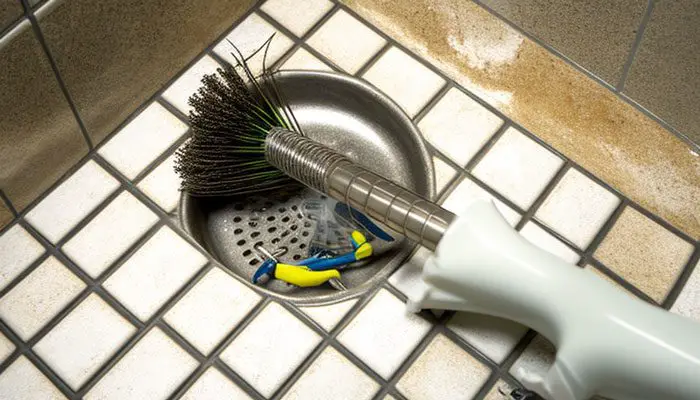
Safety Tips When Using Vinegar and Baking Soda for Cleaning Black Sludge
1. Always wear protective gloves when applying baking soda and vinegar to clean black sludge. The acidity in vinegar can irritate the skin, while baking soda can cause skin dryness and irritation if given in contact with the skin for too long.
2. When cleaning with vinegar and baking soda, ensure that the area is well-ventilated. As both ingredients are natural drain cleaning agents, their fumes may cause burning eyes, throat, or nasal discomfort for those sensitive to them.
3. Before beginning your cleaning process, ensure you have all the necessary safety equipment: rubber gloves, safety glasses, and a face mask are all necessary for their use to protect yourself from any potential harm caused by exposure to these chemicals.
4. If you’re using a spray bottle to mix vinegar and baking soda, ensure there is no open flame nearby, as this could ignite the reaction between these two cleaning agents and cause an explosion or fire hazard.
5. Before beginning your cleaning process, test the mixture on an inconspicuous area of the surface being cleaned to ensure it doesn’t damage or discolor it in any way.
6. Clean up spills immediately as they occur; vinegar and baking soda are naturally corrosive, so any spills left unattended could potentially damage surfaces if not cleaned up properly.
Cleaning Black Sludge with Toilet Plunger
Using a toilet plunger is perhaps the most popular way of removing black sludge from your shower drain because they are easy to use and quite effective at breaking down blockages caused by large amounts of grime accumulation over time.
Begin by filling up your bathtub drain or sink near where you need to plunge so there’s enough pressure for it to work effectively on stubborn debris buildups in narrow pipes more often found in showers than in other places around your home.
Once filled up, place the plunger over the affected area inside your shower pipe and pump vigorously up and down for 30 seconds, then pull straight back up once more to release any air trapped underneath its suction head.
This should create powerful suction which lifts out any remaining particles beneath it, such as muck or build-up grime which could be causing blockages deep within your pipes. Repeat this process until all gunk has been cleared out completely.
Safety Tips When Using Toilet Plunger for Cleaning Black Sludge
1. Wear protective rubber gloves and safety goggles. The black sludge can contain harmful bacteria, so protecting your skin and eyes from particles or splashes is important.
2. Ensure the plunger is correctly sized for the toilet bowl drain. An incorrectly sized plunger won’t create a strong seal, which will limit its effectiveness when plunging.
3. Before using the plunger, check that there isn’t anything blocking the drain, such as a foreign object or an excessive amount of sludge buildup that could prevent the plunger from creating an effective seal.
4. Always start plunging slowly at first to ensure that you have created a strong seal before applying more force on the plunger’s handle. Otherwise, you may end up just spreading black stuff around instead of dislodging it.
5. Wait ten seconds between each plunge to allow pressure to build up before continuing with more vigorous thrusts of the plunger handle until you feel resistance from whatever is blocking your drain, followed by relief when it breaks free and drains away.
How Does Black Sludge Form in Shower Drain Pipes?
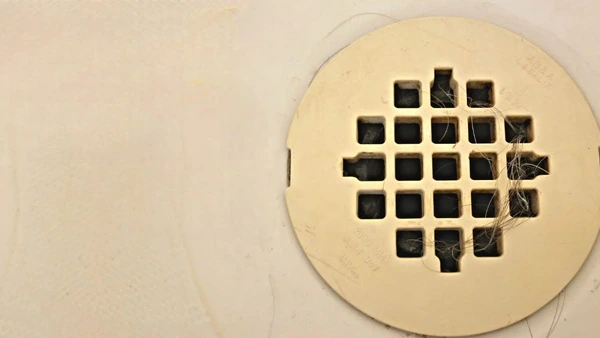
Black sludge is a combination of bacteria, hair, soap scum, skin cells, and other organic material that has built up over time in the pipes of shower drains. The bacteria are primarily caused by anaerobic organisms that live in the oxygen-deprived environment deep within the piping.
These bacteria consume the organic material found at the bottom of the pipe and excrete a black slime as they reproduce. This slime builds up on top of existing debris and can eventually cause blockages, increasing pressure on incoming and outgoing water flows.
Eventually, this build-up forms a thick layer of black sludge around the shower drain, leading to clogged shower drain pipes, causing slow draining shower and even infrared sensor readings that signify a high level of bacterial activity.
Potential Consequences of Having Black Sludge in Your Shower Drain
The presence of black sludge in the shower drain can have several consequences if left untreated for too long. Aside from emitting foul odors from the drain, black sludge can also cause clogged or slow-draining pipes due to its thickness and accumulation throughout the piping system.
Furthermore, an unsightly buildup of black sludge may accumulate on surfaces inside or outside your shower drain system, potentially leading to corrosion over time if allowed to remain unchecked.
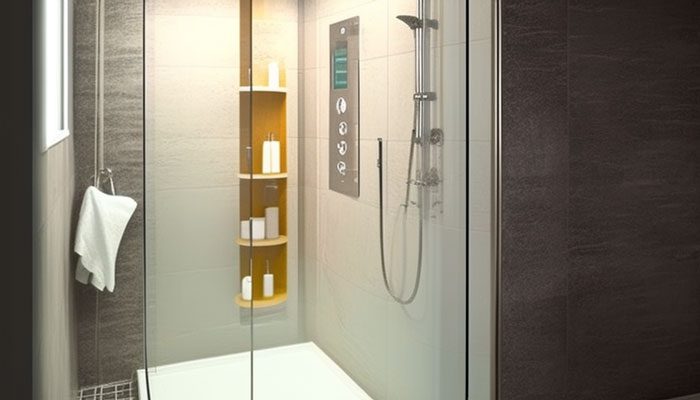
In some cases, these layers might become so thick that water cannot flow properly through them, causing further damage to plumbing fixtures and resulting in costly repairs down the drain line.
Also, harmful bacteria colonies can grow within this layer of black sludge due to its moist environment. These colonies may lead to infection or disease if subjected to human contact through broken skin or ingestion.
How Often Should You Clean the Shower Drain Black Sludge?
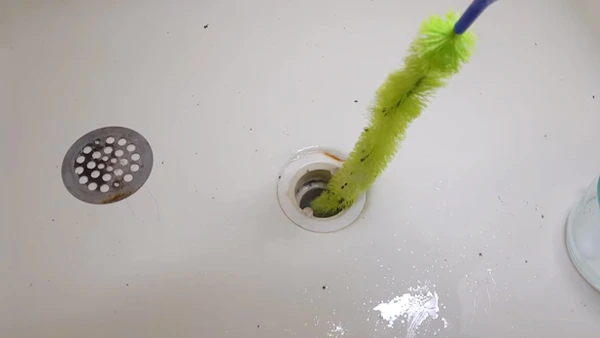
Cleaning a shower drain to eliminate black sludge should be done regularly & it is recommended that a shower drain be cleaned at least once a month to remove the build-up of black sludge.
This regular maintenance can help prevent clogging of the drain as well as keep it free from any unpleasant odors or potential health hazards.
In addition to monthly black sludge cleanings, it is also essential to pay special attention to areas where water gathers, such as around the edges of bathtubs and sinks, where mold can grow in moist environments due to bacterial activity.
Can You Put Bleach Down the Shower Drain to Remove Black Sludge?
Yes, bleach can remove black sludge buildup in your shower drain, but this should only be done when absolutely necessary and with extreme caution.
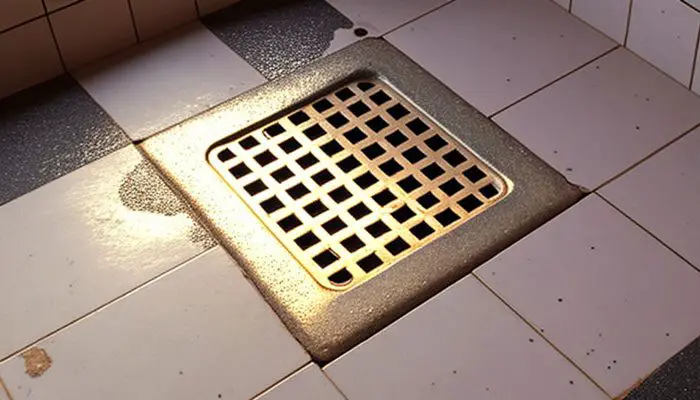
The chlorine in bleach is very effective at breaking down organic matter, such as hair and soap scum, but it can also damage metal pipes if used too frequently or in high concentrations. You should only use harsh chemicals like bleach after trying all the other methods mentioned above.
How to Prevent Future Black Sludge in Shower Drains?
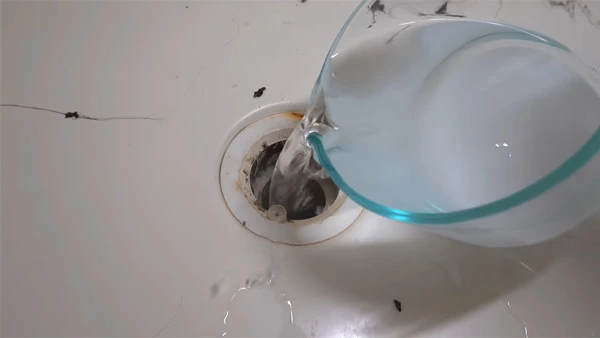
Preventing future buildups of black sludge in shower drains can be achieved through several measures, such as:
- Whenever you rinse off soap or detergent residue after each use, use hot water to keep these substances from accumulating inside the pipes or around the fixtures.
- You should regularly clean out any hair or organic matter from inside your shower drains, as this debris often catalyzes further buildups of sludge inside pipes.
- Installing a water softener if you have hard water can also help reduce levels of soap scum accumulation which combats future buildup, along with pouring boiling water down the drain at least once every month.
- Installing a mesh filter over the entrance of your shower drain helps prevent materials like hair and other debris from entering into pipes while trapping loose particles, which could contribute towards further buildups over time.
All these prevention measures will undoubtedly go far in protecting against future issues related to black sludge inside your shower drains.
Maintain Your Shower Drain and Avoid Unpleasant Surprises From Black Sludge
Cleaning black sludge from shower drain pipes is integral to any home maintenance regimen. Although it may seem daunting, you can complete the task quickly and effectively with the right supplies and procedure outlined above. The key is to catch the problem early and act on it before it becomes a bigger issue.
Regular cleaning and maintenance of your shower drain help to prevent black sludge from forming in the first place. So, don’t wait for signs of black sludge to appear; just take proactive steps to keep your pipes clean.
But if you end up with black sludge in your shower drains, try to follow the methods above as immediately as possible. Doing so will save you from having to deal with more serious problems in the future.
Relevant Article To Read:

